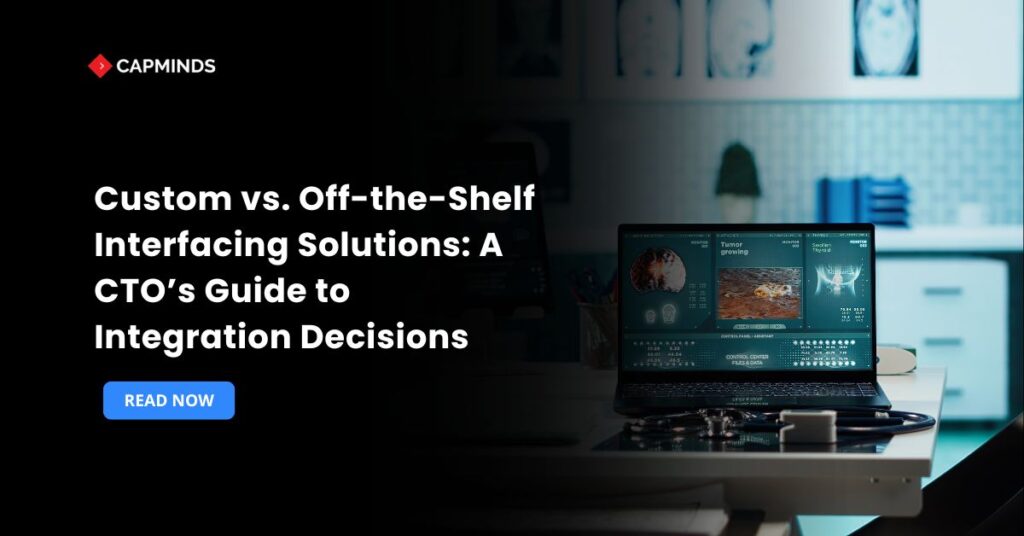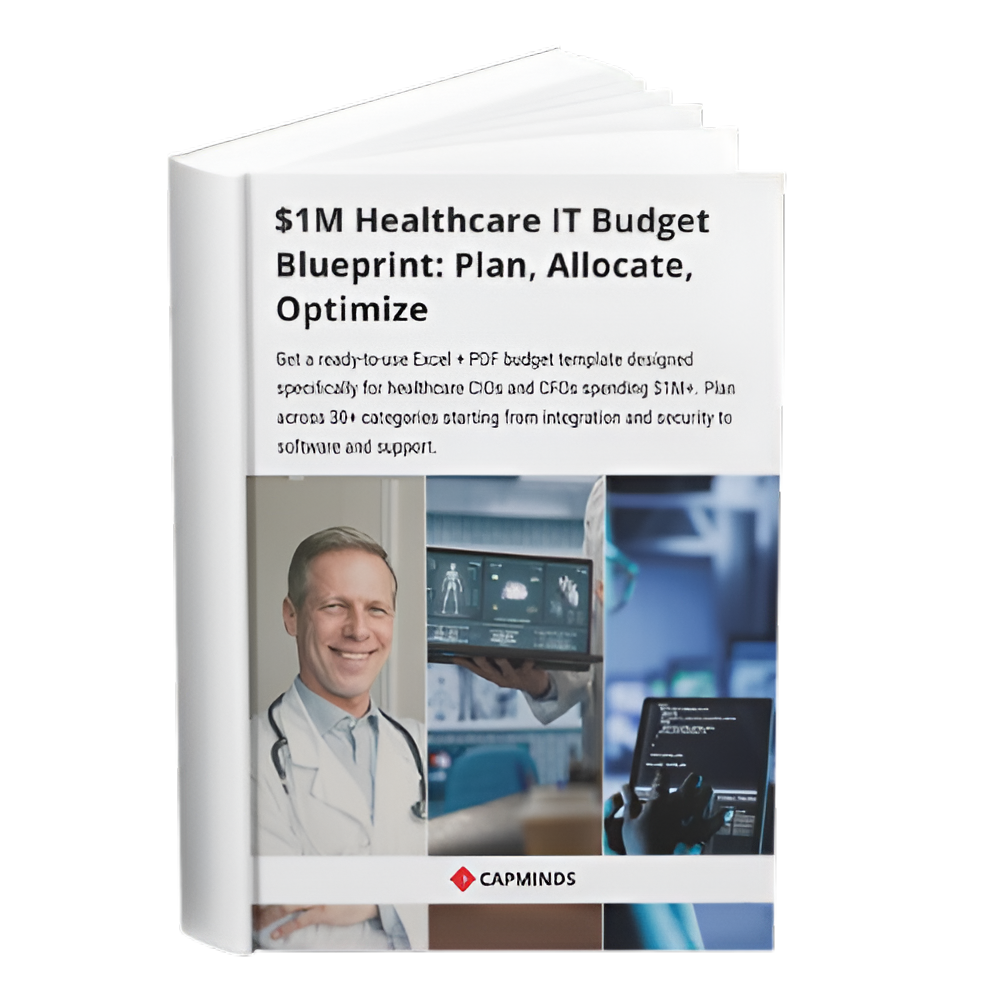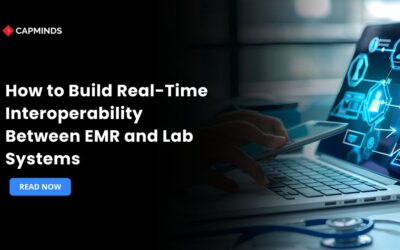Custom vs. Off-the-Shelf Interfacing Solutions: A CTO’s Guide to Integration Decisions
Health-system CTOs must balance connecting several clinical, revenue-cycle, and auxiliary applications while maintaining budgets and innovation. There are two main approaches: one is creating a custom interface engine or using a commercial, off-the-shelf integration platform.
Both methods can facilitate data flow, but their impact on scalability, security, TCO, and long-term agility varies significantly. In this blog, you’ll learn about trade-offs for selecting and defending an integration approach that fits your technological roadmap and organizational risk profile.
Why is the Integration Strategy More Important?
Excessive Data Expansion
By 2027, the volume of healthcare data in the US is expected to increase every twelve hours. Today’s streaming vitals, genomics, and patient-generated data cannot be handled by interfaces designed for transaction counts from the past.
Value-based Care Pressures
Real-time insights throughout the continuum are required for bundled payments and risk-sharing contracts, rather than retrospective batch files.
Cybersecurity Risks
One improperly built HL7 listener can lead to ransomware. A centralized and well-governed integration layer lowers the attack surface. Integration is no longer just an IT plumbing effort; it is a critical infrastructure for clinical, operational, and financial performance.
What is “Custom” and “Off‑the‑Shelf” Interface Engine?
Custom Interface Engine
A customized solution developed in-house or by a systems integrator, frequently utilizing open-source components such as Mirth Connect, Apache Camel, and custom REST middleware.
Use Cases – Niche procedures, innovative data standards, and tight IP protection.
Fine-grained customization for internal operations.
Typical Stack – Java, .NET, Node.js, Go, Python + open‑source libraries for HL7 v2, FHIR, X12, DICOM.
Off‑the‑Shelf Platform
Commercial products such as Corepoint, Rhapsody, Infor Cloverleaf, Redox, and InterSystems HealthShare are licensed on a subscription or perpetual basis.
Use Cases – Rapid access to mainstream EHRs, labs, imaging, and payers.
Speed and vendor-maintained regulatory updates.
Typical Stack – Corepoint, Lyniate Rhapsody, Infor Cloverleaf, NextGen Mirth Connect, Redox, AWS HealthLake Connector.
Cost Analysis: Direct, Hidden, and Long-Term
1. Initial Investment
- Purchasing servers and virtual machines, paying developers, managing the project, and purchasing version control and DevSecOps tools are all part of custom builds.
- A COTS license necessitates training seats, implementation expenses, and contract negotiation.
- If you already have integration engineers, custom is typically less expensive in the first year. However, internal labor seldom decreases, and licensing payments level out after five years.
2. Hidden Expenses
- Every new HL7 v2 segment or FHIR resource extension turns into an internal ticket, and custom code ages more quickly.
- Changes to TEFCA and USCDI are baked into the roadmaps of commercial suppliers; custom teams need to re-prioritize limited sprint capacity.
- Interfaces may be delayed for months, and costly contractor rescues may be necessary if two top interface developers leave.
Health-System CTO Evaluation Criteria Matrix
| Criterion | Custom Build | Off‑the‑Shelf Engine |
| Speed to Production | Months of design, coding, and validation—often 9–12 months to go‑live. | Pre‑built connectors cut timelines to 4–12 weeks. |
| Total Cost of Ownership | Lower upfront CAPEX but rising OPEX for maintenance, refactoring, and on‑call support. | Predictable annual subscription; higher license
fees but minimal internal upkeep. |
| Scalability & Performance | Virtually unlimited if you architect cloud autoscaling and container orchestration. | Throughput capped by vendor tiers (10k–50k HL7 msgs/min for most platforms). |
| Control & Custom Logic | Full ownership—code any edge case or proprietary data model. | Customization via visual mappers and SDKs; deep changes depend on the vendor roadmap. |
| Compliance & Security | You own HIPAA, SOC 2, and HITRUST audits end‑to‑end. | Vendor shares audit scope; BAAs and HITRUST baseline are often included. |
| Talent & Sustainability | Requires scarce HL7/FHIR developers and DevSecOps expertise; turnover risk is high. | Larger talent pool of platform admins; easier onboarding for junior analysts. |
| Vendor Lock‑In | None, but future migrations or cloud shifts are your responsibility. | Moderate—data migration needed to exist, though FHIR APIs help reduce friction. |
Technical Factors That Affect the Scale
1. Breadth of Standards
Verify if the COTS parser is available if you need to translate device-generated MQTT, NCPDP, or specialty DICOM SR flavors. Speed benefits might be lost with custom adapters.
2. Readiness for the Cloud
A large number of contemporary interface engines are containerized or SaaS based. It could make more sense to build an AWS/Azure infrastructure from scratch rather than relying on an on-premises COTS.
3. Eventing in Real Time
FHIR subscriptions and burst-heavy HL7 ADT feeds require asynchronous, event-driven patterns (Kafka, RabbitMQ). Check for native support from the vendor.
4. Toolchain for DevOps Fit
Infrastructure-as-Code and seamless CI/CD pipelines minimize deployment friction, which outdated COTS GUIs may impede.
5. Observability
Incident response is made easier by metrics (OpenTelemetry), distributed tracing, and unified logging. Examine the telemetry APIs offered by the platform.
A Five-Step Decision Checklist for CTOs
- Map Integration Is in Demand. List all data sources, projected message volumes, and SLAs. Include forthcoming developments, such as RPM and digital front-door applications.
- Calculate the 5-year TCO. Consider licensing, cloud cost, FTEs, on-call rotation, and security tools. Compare possibilities in current dollar terms.
- Score strategic differentiators. If interoperability is part of your competitive advantage, say, you’re a cloud LIS vendor, customers may score higher. For basic hospital operations, engines are enough.
- Assess Talent Readiness. Include in-house HL7 experts, FHIR architects, and DevOps developers. Using off-the-shelf solutions can help decrease risk if it’s difficult to hire or retain talent.
- Perform a Proof-of-Concept. In each model, spin up one important interface. Calculate construction hours, mistake rates, and monitoring overhead.
Best Practices for Future-proofing Your Choice
- Ensure FHIR R5-Ready Architecture – Whether custom or vendor, ensure native FHIR resources, bulk data support, and SMART-on-FHIR token handling.
- Design for Observability – Use Prometheus, Grafana, or vendor dashboards to monitor message latency, ACK/NACK rates, and queue depths.
- Automate Testing – Utilize unit tests with HL7 sample fixtures or commercial simulators to avoid faulty mappings after each update.
- Prepare for TEFCA and QHIN Enrollment – Check that your route, whether bespoke or engine, can be integrated into Qualified Health Information Networks without requiring significant refactoring.
- Negotiate Exit Clauses – If going into business, limit data export fees and obtain a 90-day wind-down license in case your plan changes.
Related: Deploying Mirth Connect for Multi-Facility Interfacing: Common Pitfalls and Fixes
Empower Your Integration Roadmap with CapMinds
Whether you build, buy, or blend, CapMinds keeps your data moving, securely, scalably, and on budget. Our healthcare‑focused engineers partner with CTOs to translate integration strategy into clinical impact.
- Custom interface engine design on Java, .NET, or Go
- Rapid deployment of market‑leading platforms (Corepoint, Rhapsody, Cloverleaf, Mirth)
- Hybrid architecture coaching for cloud, FHIR, and event streams
- 24/7 monitoring, HL7/FHIR mapping, and automated regression testing
- TEFCA‑ready security, HIPAA compliance, and HITRUST hosting
- End‑to‑end project management, from discovery workshops to training and knowledge transfer
From the first blueprint to post‑go‑live optimization, we deliver a future‑proof interoperability stack that lets clinicians see real‑time data and executives see real ROI.
Schedule a complimentary Integration Readiness Assessment today, and discover how CapMinds can accelerate your mission while protecting your investment.
Our experts have delivered 500+ successful integrations across hospitals, labs, imaging centers, and digital health vendors nationwide with zero downtime.




